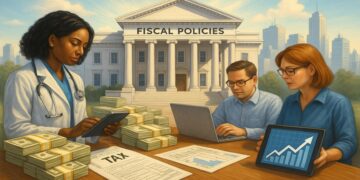How U.S. Fiscal Policy Affects the Labor Market

The Interplay of Economic Strategies and Employment
The intricate relationship between fiscal policy and the labor market in the United States plays a crucial role in shaping economic outcomes. Fiscal policy encompasses government spending and taxation strategies that significantly impact economic performance. Adjustments in these policies can lead to direct effects such as job creation, wage levels, and fluctuations in employment rates across various sectors.
Key Components of Fiscal Policy
- Government Spending: An increase in infrastructure investment not only rejuvenates public facilities but can also create thousands of jobs in construction, engineering, and related fields. For example, initiatives like the Infrastructure Investment and Jobs Act intend to modernize roads and bridges, potentially generating a substantial number of new employment opportunities.
- Taxation: Tax policies aimed at individuals and businesses can incentivize hiring and increase consumer spending. For instance, tax cuts that allow families to retain more of their income can lead to higher demand for goods and services, thus prompting businesses to expand and hire additional employees.
- Stimulus Packages: During economic downturns, such as the recent COVID-19 pandemic, targeted stimulus packages provide essential financial support to individuals and families, helping them avoid long-term unemployment. Programs like the Paycheck Protection Program (PPP) were essential in preserving jobs across various sectors during this challenging time.
Understanding how these fiscal decisions influence the job market is vital for policymakers and citizens alike. For example, the recent implementation of COVID-19 relief funds significantly affected employment levels, particularly in industries such as hospitality and retail which were hit hardest during shutdowns.
Potential Outcomes
- Job Creation: Well-designed fiscal policies tailored to U.S. economic needs can lead to an increase in job opportunities. Programs promoting green technologies or renewable energy can foster new industries alongside traditional ones.
- Wage Fluctuations: Adjustments in minimum wage laws or incentives for businesses creating higher-wage jobs can significantly affect earnings. States that have raised their minimum wages often report increased earnings for low-income workers while triggering discussions in other states about wage policy.
- Sector Variability: Different sectors experience varied impacts from fiscal policies. For instance, healthcare and technology may benefit from increased government spending, while sectors like manufacturing may face challenges if tariffs or trade policies shift.
By delving into these dimensions, we uncover a deeper understanding of the vital connection between fiscal policy and labor outcomes within the U.S. economy. This insight not only informs potential pathways toward robust economic growth but also highlights the significance of responsive fiscal strategies in building a resilient workforce aimed at overcoming future challenges.
The Mechanisms Behind Fiscal Policy and Employment Dynamics
To comprehend the effects of fiscal policy on the labor market, it is essential to explore the mechanisms through which government actions translate into economic activity. Fiscal policies can create a ripple effect, influencing job opportunities, business stability, and overall economic health. Understanding these dynamics can provide valuable insights for citizens and decision-makers alike.
The Role of Government Spending in Job Creation
Government spending serves as a vital tool in stimulating the economy, particularly during periods of recession or economic slowdown. When the government invests in public infrastructure, it offers immediate job opportunities while simultaneously laying the groundwork for future economic growth. For example, efforts to improve transportation networks can foster trade efficiency, directly impacting job creation across various sectors.
The recent push for renewable energy projects highlights this connection vividly. By allocating funds towards solar and wind energy, the government can create new jobs in engineering, manufacturing, and maintenance—all while steering the economy towards sustainable practices. According to a report by the International Renewable Energy Agency (IRENA), solar and wind industries have been among the fastest-growing job sectors in the U.S., underscoring the potential for fiscal policy to shape employment landscapes significantly.
Taxation as a Driver for Employment
Taxation, often a heated topic in U.S. politics, plays a crucial role in shaping the labor market as well. Tax incentives, deductions, and credits can stimulate business investments, encouraging companies to expand and hire more employees. For instance, the 2017 Tax Cuts and Jobs Act introduced substantial corporate tax reductions, leading many businesses to reinvest in their operations, resulting in increased hiring rates.
Furthermore, targeted tax credits for specific sectors, such as technology startups or small businesses, can spur innovation and entrepreneurship. A report from the Small Business Administration reveals that small businesses create approximately 1.5 million jobs annually in the U.S., showcasing the importance of fostering an environment conducive to their growth.
Strategies for Workforce Resilience
In a world shaped by digital transformation and economic shifts, the flexibility of fiscal policy must be matched by initiatives that prepare the workforce for emerging challenges. Consider the implications of comprehensive retraining programs funded by fiscal initiatives. Such programs not only aid displaced workers during economic transitions but also equip the future workforce with in-demand skills necessary for a rapidly evolving job market.
- Support for Education and Training: Investing in education and vocational training can alleviate disparities in employment opportunities, particularly for marginalized communities.
- Business Incentives: Programs encouraging companies to invest in employee training can bolster the skills of their workforce, leading to higher productivity and job satisfaction.
- Public-Private Partnerships: Collaborative efforts between the government and private sector can enhance access to training and job placement services, ultimately fostering economic resilience.
These strategic approaches highlight the need for coordinated efforts in fiscal policy that not only address immediate employment concerns but also pave the way for a stronger labor force capable of adapting to future market demands. As the U.S. navigates through economic uncertainties, the ability to align fiscal measures with labor market needs will be crucial in promoting stability and growth. Understanding these mechanisms allows stakeholders to harness the full potential of fiscal policy in shaping a brighter economic future.
Transforming Economic Stability Through Gender and Workforce Inclusivity
Another pivotal aspect of fiscal policy’s influence on the labor market lies in its potential to promote gender and workforce inclusivity. As the U.S. grapples with persistent income inequality and underemployment in specific demographics, targeted fiscal measures can serve to level the playing field and tap into underutilized labor resources. This is particularly relevant in an economy transitioning towards a knowledge-based framework where diverse perspectives can enhance innovation and productivity.
Incentivizing Workforce Diversity
The integration of women and minorities into the labor force brings not only ethical advantages but also economic benefits. Research from the McKinsey Global Institute reveals that achieving gender parity could add $12 trillion to global GDP by 2025, illustrating the potential impact of inclusive labor practices. Fiscal policies aimed at supporting these efforts, such as tax deductions for companies that promote diversity or grants for minority-owned businesses, can alleviate systemic barriers and foster a more equitable labor market.
Programs such as the Women-Owned Small Business Federal Contracting Program highlight how fiscal policies can target specific demographics. These initiatives aim to increase the capacity and competitiveness of women-owned businesses, facilitating growth and ultimately leading to job creation. As these enterprises thrive, they contribute to the broader economy while helping to reduce gender disparities in employment.
Public Investment in Childcare and Family Support
Childcare remains a significant barrier for many working parents, affecting their ability to join or remain in the labor force. Here, fiscal policies that allocate funding for accessible childcare services can have transformative effects. Affordable childcare support not only alleviates financial strain but also empowers parents, particularly mothers, to pursue their career ambitions without the burden of excessive costs.
Investments in parental leave programs and flexible work arrangements can further enhance family support structures. These interventions provide families with options while simultaneously boosting workplace participation rates. According to the Institute for Women’s Policy Research, policies that support working families can increase participation rates among prime-age women by up to 5%. This marked increase illustrates how strategic fiscal initiatives can translate into greater workforce inclusion and economic durability.
The Role of Economic Stabilization Policies
Beyond direct job creation and inclusivity initiatives, fiscal policy’s role in economic stabilization cannot be overstated. During economic downturns, countercyclical fiscal measures, such as stimulus packages, serve to cushion the blow and foster recovery. For instance, the Coronavirus Aid, Relief, and Economic Security (CARES) Act provided crucial financial relief to individuals and businesses, effectively preventing large-scale layoffs and preserving millions of jobs. As increases in unemployment benefits and direct cash payments launched consumer spending, the economy began to regain its footing.
This connection emphasizes the need for agile fiscal responses that can adapt to labor market conditions. By prioritizing stabilization through timely interventions, fiscal policy enables businesses to remain afloat and retain employees, even during challenging economic environments. Such resilience not only assists in immediate recovery but ensures a robust labor market moving forward.
Exploring these dimensions of fiscal policy reveals profound avenues for maximizing labor market potential. As the U.S. considers its economic roadmap, integrating inclusivity, support for families, and effective stabilization measures will be pivotal in cultivating a workforce that is both diverse and dynamic, ultimately leading to a sustainable and prosperous economic future.
Conclusion: A Comprehensive Understanding of Fiscal Policy’s Impact on the Labor Market
In summary, the intricate relationship between U.S. fiscal policy and the labor market is underscored by its capacity to drive economic growth, enhance inclusivity, and ensure stability during tumultuous times. As demonstrated, targeted fiscal measures can effectively reduce barriers for underrepresented groups, facilitating a more diverse and dynamic workforce. This not only contributes to societal equity but also enhances economic productivity; estimates suggest that achieving gender parity could add a staggering $12 trillion to global GDP by 2025.
Additionally, investments in public services such as childcare and family support systems showcase how fiscal policy can address pressing obstacles that hinder workforce participation. By prioritizing such initiatives, lawmakers can empower parents, particularly mothers, and catalyze greater engagement in the labor market, underscoring the role of sound fiscal policymaking in reversing trends of underemployment.
Moreover, economic stabilization policies, such as stimulus packages, play a critical role in maintaining labor market resilience during downturns, ensuring that businesses can sustain their workforce in the face of economic challenges. The success of recent initiatives, like the CARES Act, exemplifies how timely fiscal responses can buffer adverse effects and foster recovery, thereby promoting a healthier labor market.
As the U.S. navigates its fiscal future, it must adopt a holistic approach that embraces inclusivity, supports families, and prepares for economic fluctuations. By doing so, policymakers can harness the full potential of the labor market, paving the way for a sustainable and prosperous economic landscape that benefits all citizens. Exploring these dynamics further can illuminate opportunities for more strategic fiscal frameworks that serve both individuals and the economy effectively.

James Carter is a financial writer and consultant with expertise in economics, personal finance, and investment strategies. With years of experience helping individuals and businesses navigate complex financial decisions, James provides practical insights and analysis. His goal is to empower readers with the knowledge they need to achieve financial success.





